Evaluating Customer Journeys: A WHSmith and H&M E-commerce Comparison
VerifiedAdded on 2023/04/20
|9
|2130
|175
Report
AI Summary
This report provides a comparative analysis of the customer journeys within the e-commerce platforms of WHSmith and H&M, focusing on key stages such as online search, evaluation, purchase, and post-purchase engagement. It examines how both companies create product awareness, manage customer experience, and ensure customer retention to maximize profits. The report explores the customer journey models employed by each company, considering touchpoints, calls to action, and other relevant e-commerce concepts. By understanding customer purchasing life cycle, the report highlights how these businesses adjust their market strategies and leverage tools like customer journey maps and the customer hourglass framework to enhance customer relationships and drive business growth.
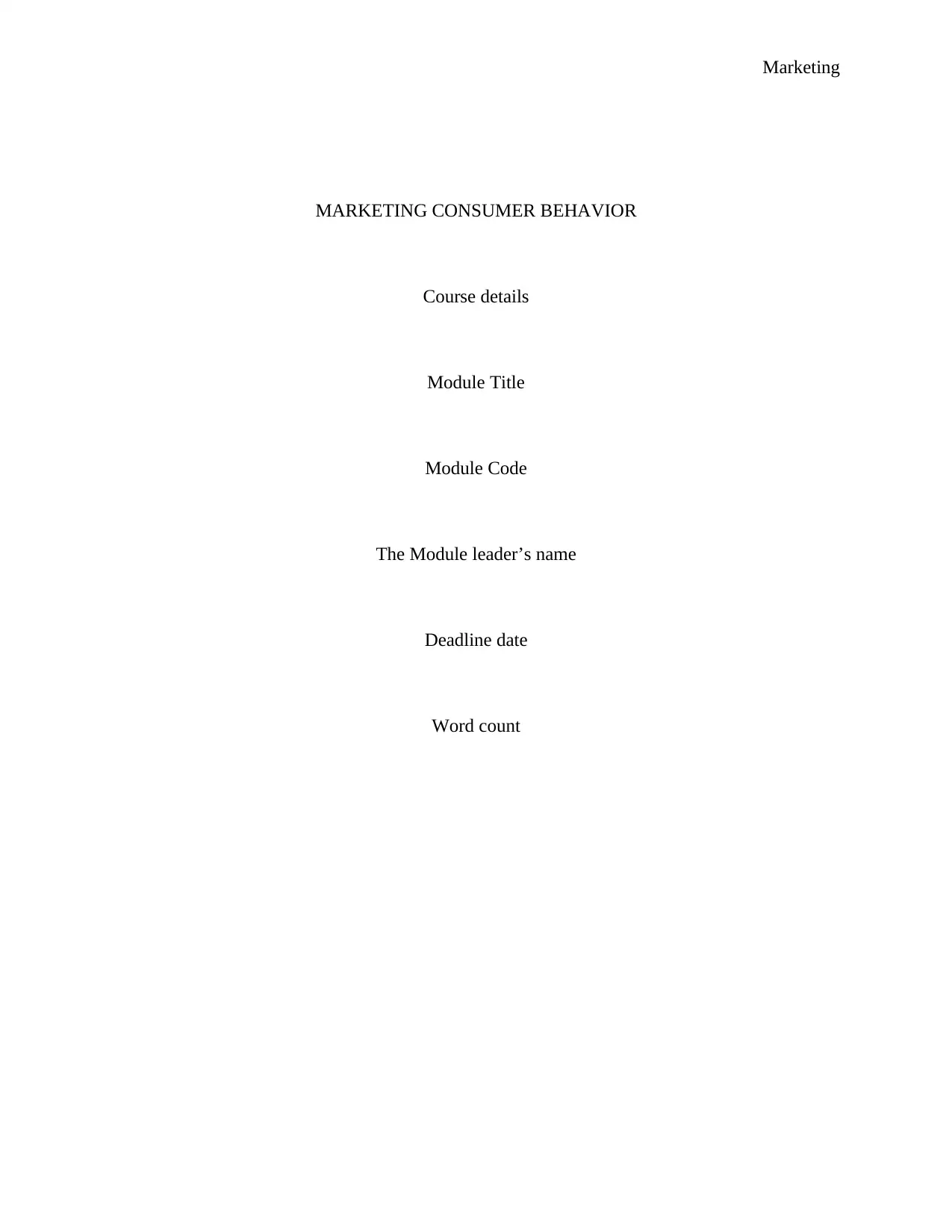
Marketing
MARKETING CONSUMER BEHAVIOR
Course details
Module Title
Module Code
The Module leader’s name
Deadline date
Word count
MARKETING CONSUMER BEHAVIOR
Course details
Module Title
Module Code
The Module leader’s name
Deadline date
Word count
Paraphrase This Document
Need a fresh take? Get an instant paraphrase of this document with our AI Paraphraser
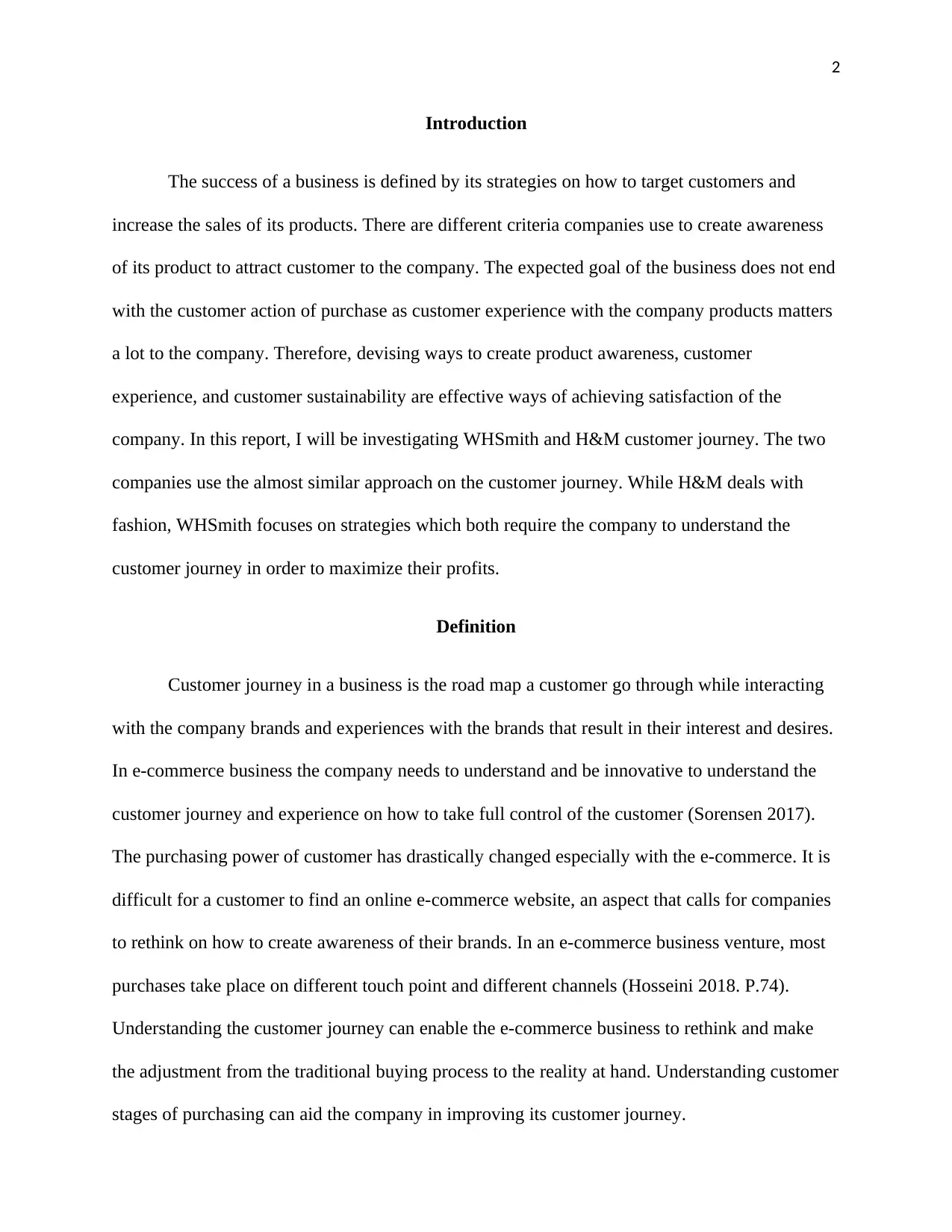
2
Introduction
The success of a business is defined by its strategies on how to target customers and
increase the sales of its products. There are different criteria companies use to create awareness
of its product to attract customer to the company. The expected goal of the business does not end
with the customer action of purchase as customer experience with the company products matters
a lot to the company. Therefore, devising ways to create product awareness, customer
experience, and customer sustainability are effective ways of achieving satisfaction of the
company. In this report, I will be investigating WHSmith and H&M customer journey. The two
companies use the almost similar approach on the customer journey. While H&M deals with
fashion, WHSmith focuses on strategies which both require the company to understand the
customer journey in order to maximize their profits.
Definition
Customer journey in a business is the road map a customer go through while interacting
with the company brands and experiences with the brands that result in their interest and desires.
In e-commerce business the company needs to understand and be innovative to understand the
customer journey and experience on how to take full control of the customer (Sorensen 2017).
The purchasing power of customer has drastically changed especially with the e-commerce. It is
difficult for a customer to find an online e-commerce website, an aspect that calls for companies
to rethink on how to create awareness of their brands. In an e-commerce business venture, most
purchases take place on different touch point and different channels (Hosseini 2018. P.74).
Understanding the customer journey can enable the e-commerce business to rethink and make
the adjustment from the traditional buying process to the reality at hand. Understanding customer
stages of purchasing can aid the company in improving its customer journey.
Introduction
The success of a business is defined by its strategies on how to target customers and
increase the sales of its products. There are different criteria companies use to create awareness
of its product to attract customer to the company. The expected goal of the business does not end
with the customer action of purchase as customer experience with the company products matters
a lot to the company. Therefore, devising ways to create product awareness, customer
experience, and customer sustainability are effective ways of achieving satisfaction of the
company. In this report, I will be investigating WHSmith and H&M customer journey. The two
companies use the almost similar approach on the customer journey. While H&M deals with
fashion, WHSmith focuses on strategies which both require the company to understand the
customer journey in order to maximize their profits.
Definition
Customer journey in a business is the road map a customer go through while interacting
with the company brands and experiences with the brands that result in their interest and desires.
In e-commerce business the company needs to understand and be innovative to understand the
customer journey and experience on how to take full control of the customer (Sorensen 2017).
The purchasing power of customer has drastically changed especially with the e-commerce. It is
difficult for a customer to find an online e-commerce website, an aspect that calls for companies
to rethink on how to create awareness of their brands. In an e-commerce business venture, most
purchases take place on different touch point and different channels (Hosseini 2018. P.74).
Understanding the customer journey can enable the e-commerce business to rethink and make
the adjustment from the traditional buying process to the reality at hand. Understanding customer
stages of purchasing can aid the company in improving its customer journey.
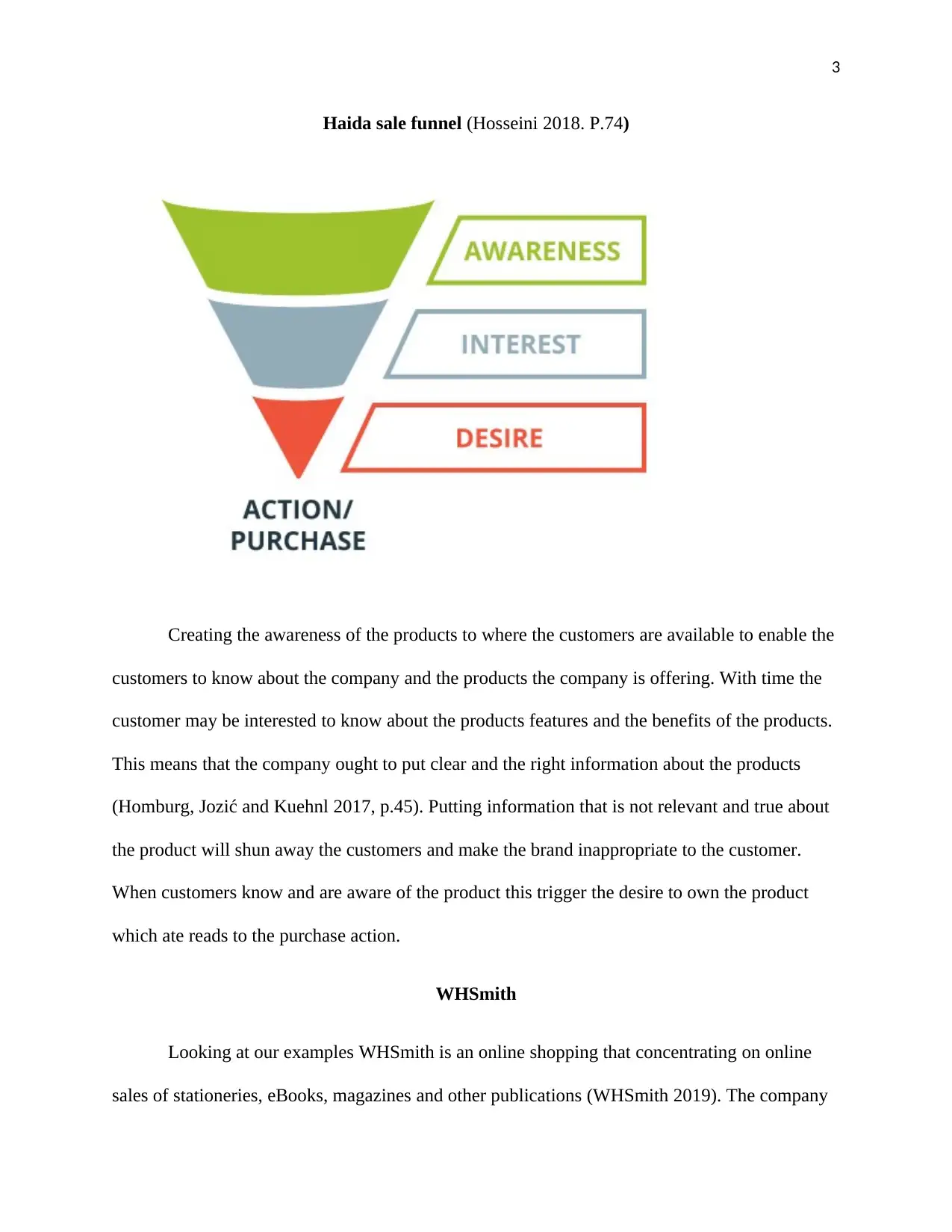
3
Haida sale funnel (Hosseini 2018. P.74)
Creating the awareness of the products to where the customers are available to enable the
customers to know about the company and the products the company is offering. With time the
customer may be interested to know about the products features and the benefits of the products.
This means that the company ought to put clear and the right information about the products
(Homburg, Jozić and Kuehnl 2017, p.45). Putting information that is not relevant and true about
the product will shun away the customers and make the brand inappropriate to the customer.
When customers know and are aware of the product this trigger the desire to own the product
which ate reads to the purchase action.
WHSmith
Looking at our examples WHSmith is an online shopping that concentrating on online
sales of stationeries, eBooks, magazines and other publications (WHSmith 2019). The company
Haida sale funnel (Hosseini 2018. P.74)
Creating the awareness of the products to where the customers are available to enable the
customers to know about the company and the products the company is offering. With time the
customer may be interested to know about the products features and the benefits of the products.
This means that the company ought to put clear and the right information about the products
(Homburg, Jozić and Kuehnl 2017, p.45). Putting information that is not relevant and true about
the product will shun away the customers and make the brand inappropriate to the customer.
When customers know and are aware of the product this trigger the desire to own the product
which ate reads to the purchase action.
WHSmith
Looking at our examples WHSmith is an online shopping that concentrating on online
sales of stationeries, eBooks, magazines and other publications (WHSmith 2019). The company
⊘ This is a preview!⊘
Do you want full access?
Subscribe today to unlock all pages.

Trusted by 1+ million students worldwide
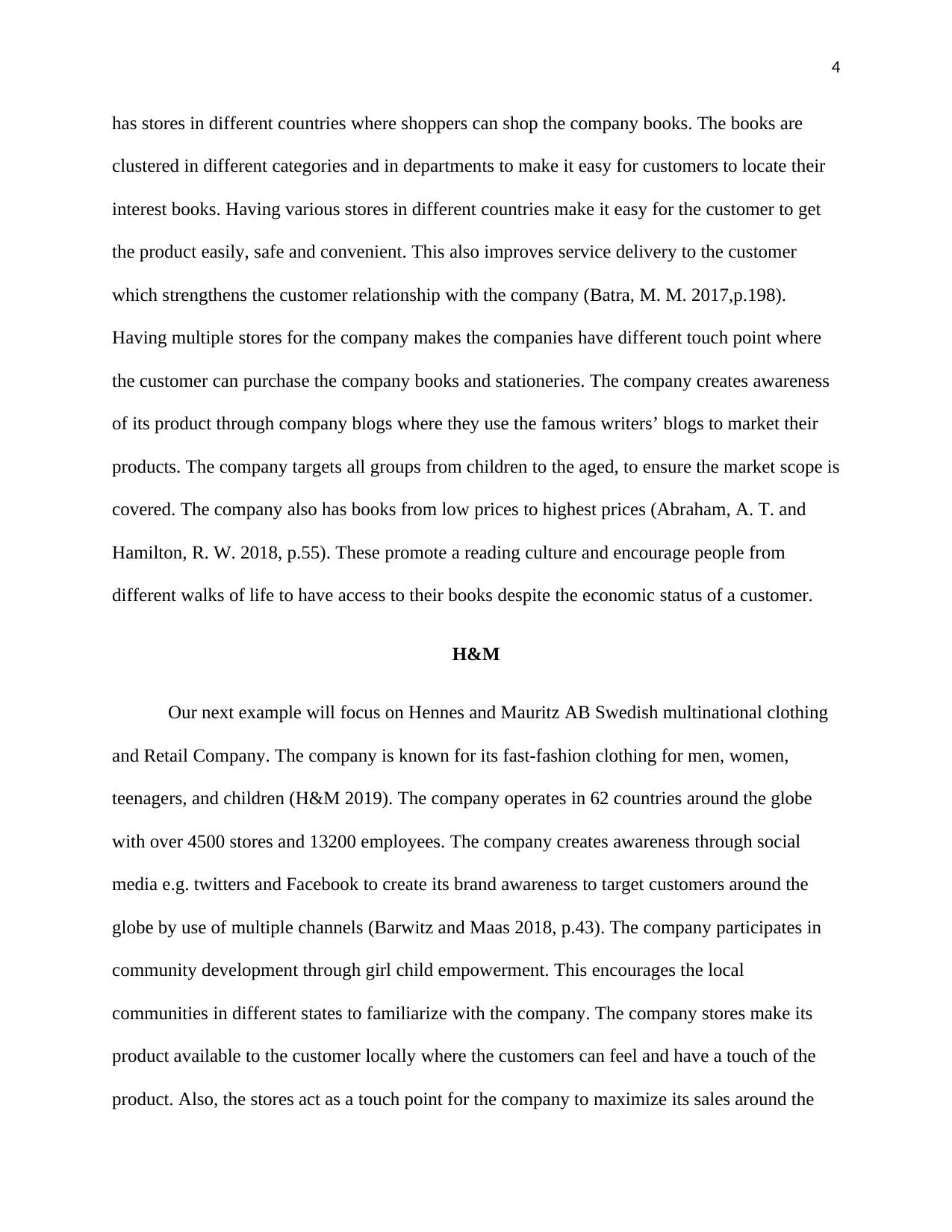
4
has stores in different countries where shoppers can shop the company books. The books are
clustered in different categories and in departments to make it easy for customers to locate their
interest books. Having various stores in different countries make it easy for the customer to get
the product easily, safe and convenient. This also improves service delivery to the customer
which strengthens the customer relationship with the company (Batra, M. M. 2017,p.198).
Having multiple stores for the company makes the companies have different touch point where
the customer can purchase the company books and stationeries. The company creates awareness
of its product through company blogs where they use the famous writers’ blogs to market their
products. The company targets all groups from children to the aged, to ensure the market scope is
covered. The company also has books from low prices to highest prices (Abraham, A. T. and
Hamilton, R. W. 2018, p.55). These promote a reading culture and encourage people from
different walks of life to have access to their books despite the economic status of a customer.
H&M
Our next example will focus on Hennes and Mauritz AB Swedish multinational clothing
and Retail Company. The company is known for its fast-fashion clothing for men, women,
teenagers, and children (H&M 2019). The company operates in 62 countries around the globe
with over 4500 stores and 13200 employees. The company creates awareness through social
media e.g. twitters and Facebook to create its brand awareness to target customers around the
globe by use of multiple channels (Barwitz and Maas 2018, p.43). The company participates in
community development through girl child empowerment. This encourages the local
communities in different states to familiarize with the company. The company stores make its
product available to the customer locally where the customers can feel and have a touch of the
product. Also, the stores act as a touch point for the company to maximize its sales around the
has stores in different countries where shoppers can shop the company books. The books are
clustered in different categories and in departments to make it easy for customers to locate their
interest books. Having various stores in different countries make it easy for the customer to get
the product easily, safe and convenient. This also improves service delivery to the customer
which strengthens the customer relationship with the company (Batra, M. M. 2017,p.198).
Having multiple stores for the company makes the companies have different touch point where
the customer can purchase the company books and stationeries. The company creates awareness
of its product through company blogs where they use the famous writers’ blogs to market their
products. The company targets all groups from children to the aged, to ensure the market scope is
covered. The company also has books from low prices to highest prices (Abraham, A. T. and
Hamilton, R. W. 2018, p.55). These promote a reading culture and encourage people from
different walks of life to have access to their books despite the economic status of a customer.
H&M
Our next example will focus on Hennes and Mauritz AB Swedish multinational clothing
and Retail Company. The company is known for its fast-fashion clothing for men, women,
teenagers, and children (H&M 2019). The company operates in 62 countries around the globe
with over 4500 stores and 13200 employees. The company creates awareness through social
media e.g. twitters and Facebook to create its brand awareness to target customers around the
globe by use of multiple channels (Barwitz and Maas 2018, p.43). The company participates in
community development through girl child empowerment. This encourages the local
communities in different states to familiarize with the company. The company stores make its
product available to the customer locally where the customers can feel and have a touch of the
product. Also, the stores act as a touch point for the company to maximize its sales around the
Paraphrase This Document
Need a fresh take? Get an instant paraphrase of this document with our AI Paraphraser
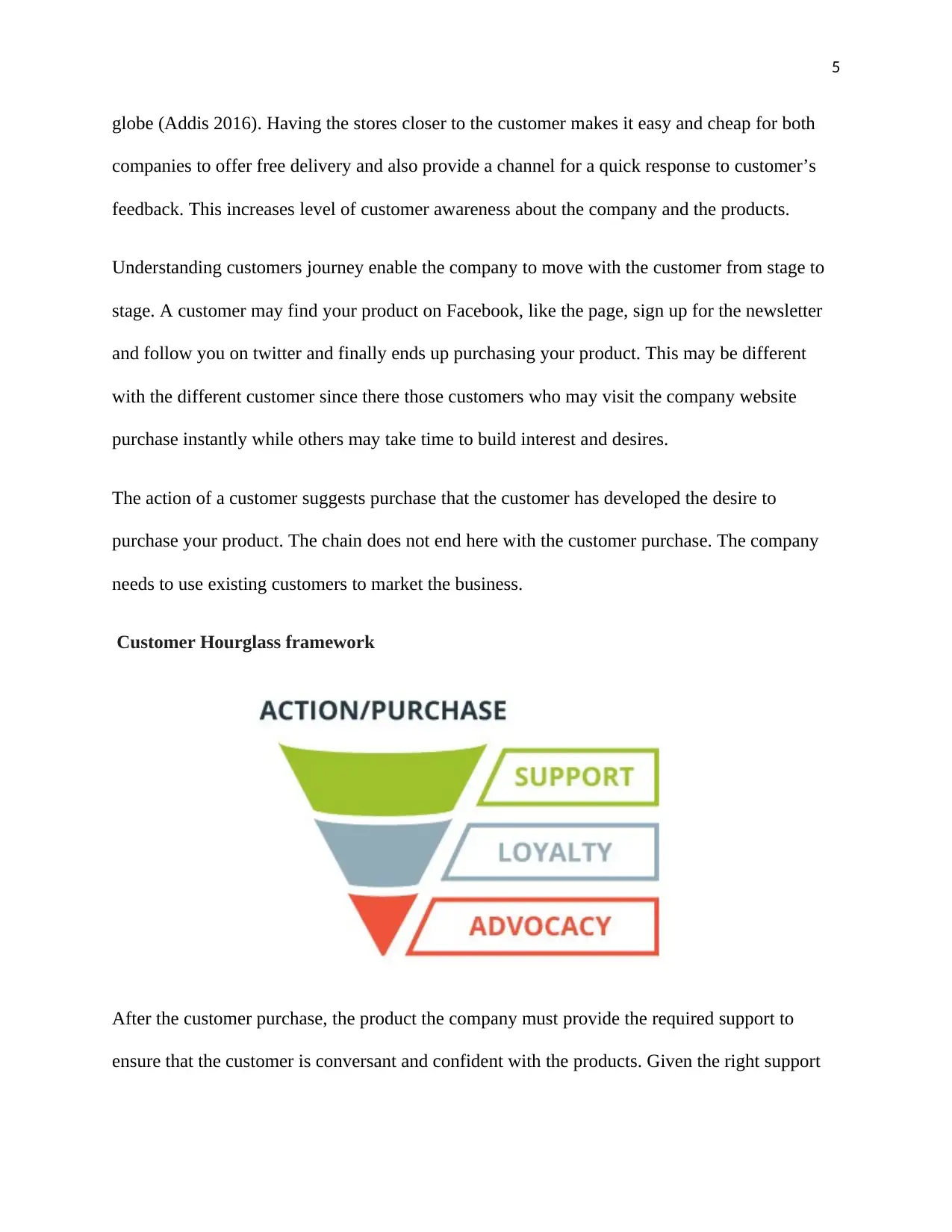
5
globe (Addis 2016). Having the stores closer to the customer makes it easy and cheap for both
companies to offer free delivery and also provide a channel for a quick response to customer’s
feedback. This increases level of customer awareness about the company and the products.
Understanding customers journey enable the company to move with the customer from stage to
stage. A customer may find your product on Facebook, like the page, sign up for the newsletter
and follow you on twitter and finally ends up purchasing your product. This may be different
with the different customer since there those customers who may visit the company website
purchase instantly while others may take time to build interest and desires.
The action of a customer suggests purchase that the customer has developed the desire to
purchase your product. The chain does not end here with the customer purchase. The company
needs to use existing customers to market the business.
Customer Hourglass framework
After the customer purchase, the product the company must provide the required support to
ensure that the customer is conversant and confident with the products. Given the right support
globe (Addis 2016). Having the stores closer to the customer makes it easy and cheap for both
companies to offer free delivery and also provide a channel for a quick response to customer’s
feedback. This increases level of customer awareness about the company and the products.
Understanding customers journey enable the company to move with the customer from stage to
stage. A customer may find your product on Facebook, like the page, sign up for the newsletter
and follow you on twitter and finally ends up purchasing your product. This may be different
with the different customer since there those customers who may visit the company website
purchase instantly while others may take time to build interest and desires.
The action of a customer suggests purchase that the customer has developed the desire to
purchase your product. The chain does not end here with the customer purchase. The company
needs to use existing customers to market the business.
Customer Hourglass framework
After the customer purchase, the product the company must provide the required support to
ensure that the customer is conversant and confident with the products. Given the right support
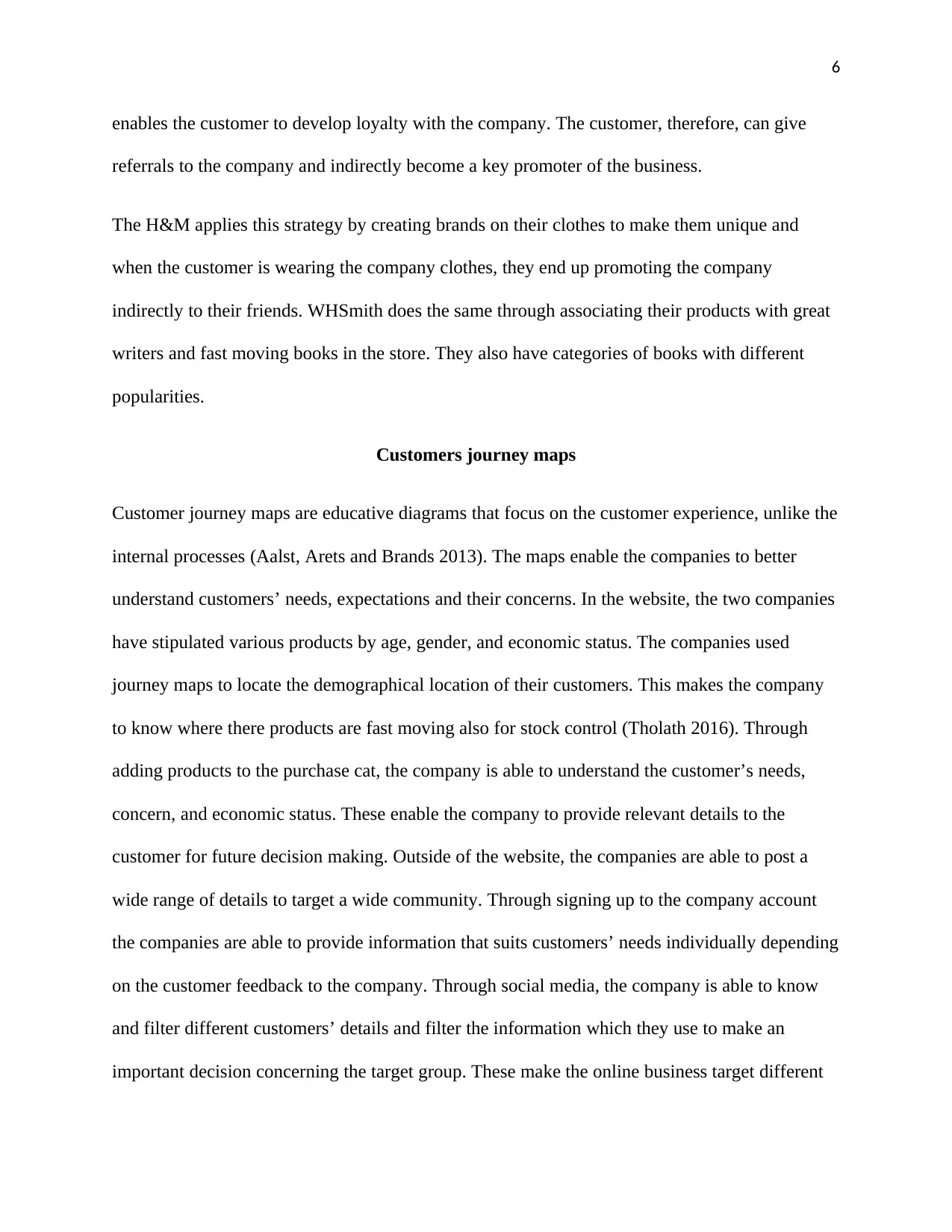
6
enables the customer to develop loyalty with the company. The customer, therefore, can give
referrals to the company and indirectly become a key promoter of the business.
The H&M applies this strategy by creating brands on their clothes to make them unique and
when the customer is wearing the company clothes, they end up promoting the company
indirectly to their friends. WHSmith does the same through associating their products with great
writers and fast moving books in the store. They also have categories of books with different
popularities.
Customers journey maps
Customer journey maps are educative diagrams that focus on the customer experience, unlike the
internal processes (Aalst, Arets and Brands 2013). The maps enable the companies to better
understand customers’ needs, expectations and their concerns. In the website, the two companies
have stipulated various products by age, gender, and economic status. The companies used
journey maps to locate the demographical location of their customers. This makes the company
to know where there products are fast moving also for stock control (Tholath 2016). Through
adding products to the purchase cat, the company is able to understand the customer’s needs,
concern, and economic status. These enable the company to provide relevant details to the
customer for future decision making. Outside of the website, the companies are able to post a
wide range of details to target a wide community. Through signing up to the company account
the companies are able to provide information that suits customers’ needs individually depending
on the customer feedback to the company. Through social media, the company is able to know
and filter different customers’ details and filter the information which they use to make an
important decision concerning the target group. These make the online business target different
enables the customer to develop loyalty with the company. The customer, therefore, can give
referrals to the company and indirectly become a key promoter of the business.
The H&M applies this strategy by creating brands on their clothes to make them unique and
when the customer is wearing the company clothes, they end up promoting the company
indirectly to their friends. WHSmith does the same through associating their products with great
writers and fast moving books in the store. They also have categories of books with different
popularities.
Customers journey maps
Customer journey maps are educative diagrams that focus on the customer experience, unlike the
internal processes (Aalst, Arets and Brands 2013). The maps enable the companies to better
understand customers’ needs, expectations and their concerns. In the website, the two companies
have stipulated various products by age, gender, and economic status. The companies used
journey maps to locate the demographical location of their customers. This makes the company
to know where there products are fast moving also for stock control (Tholath 2016). Through
adding products to the purchase cat, the company is able to understand the customer’s needs,
concern, and economic status. These enable the company to provide relevant details to the
customer for future decision making. Outside of the website, the companies are able to post a
wide range of details to target a wide community. Through signing up to the company account
the companies are able to provide information that suits customers’ needs individually depending
on the customer feedback to the company. Through social media, the company is able to know
and filter different customers’ details and filter the information which they use to make an
important decision concerning the target group. These make the online business target different
⊘ This is a preview!⊘
Do you want full access?
Subscribe today to unlock all pages.

Trusted by 1+ million students worldwide
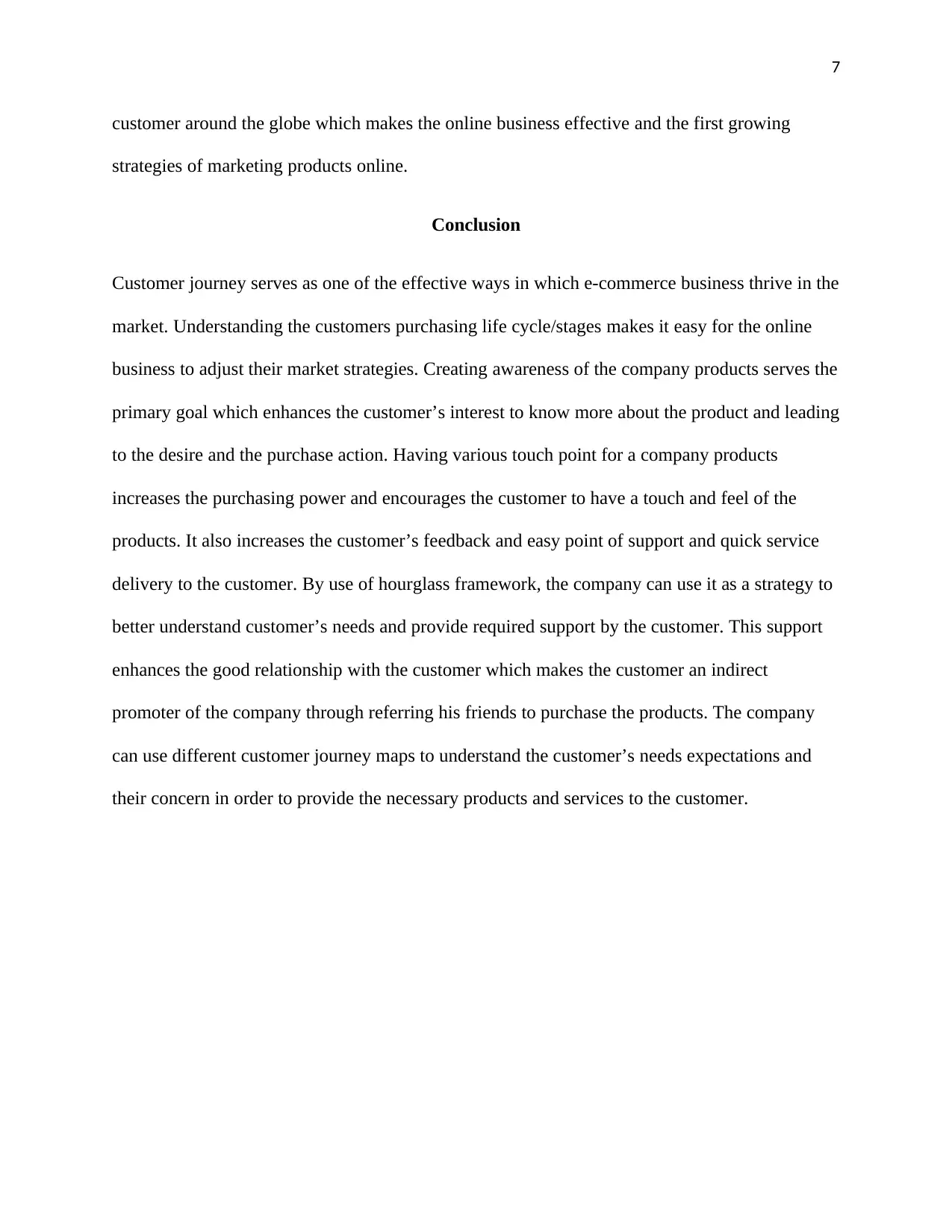
7
customer around the globe which makes the online business effective and the first growing
strategies of marketing products online.
Conclusion
Customer journey serves as one of the effective ways in which e-commerce business thrive in the
market. Understanding the customers purchasing life cycle/stages makes it easy for the online
business to adjust their market strategies. Creating awareness of the company products serves the
primary goal which enhances the customer’s interest to know more about the product and leading
to the desire and the purchase action. Having various touch point for a company products
increases the purchasing power and encourages the customer to have a touch and feel of the
products. It also increases the customer’s feedback and easy point of support and quick service
delivery to the customer. By use of hourglass framework, the company can use it as a strategy to
better understand customer’s needs and provide required support by the customer. This support
enhances the good relationship with the customer which makes the customer an indirect
promoter of the company through referring his friends to purchase the products. The company
can use different customer journey maps to understand the customer’s needs expectations and
their concern in order to provide the necessary products and services to the customer.
customer around the globe which makes the online business effective and the first growing
strategies of marketing products online.
Conclusion
Customer journey serves as one of the effective ways in which e-commerce business thrive in the
market. Understanding the customers purchasing life cycle/stages makes it easy for the online
business to adjust their market strategies. Creating awareness of the company products serves the
primary goal which enhances the customer’s interest to know more about the product and leading
to the desire and the purchase action. Having various touch point for a company products
increases the purchasing power and encourages the customer to have a touch and feel of the
products. It also increases the customer’s feedback and easy point of support and quick service
delivery to the customer. By use of hourglass framework, the company can use it as a strategy to
better understand customer’s needs and provide required support by the customer. This support
enhances the good relationship with the customer which makes the customer an indirect
promoter of the company through referring his friends to purchase the products. The company
can use different customer journey maps to understand the customer’s needs expectations and
their concern in order to provide the necessary products and services to the customer.
Paraphrase This Document
Need a fresh take? Get an instant paraphrase of this document with our AI Paraphraser
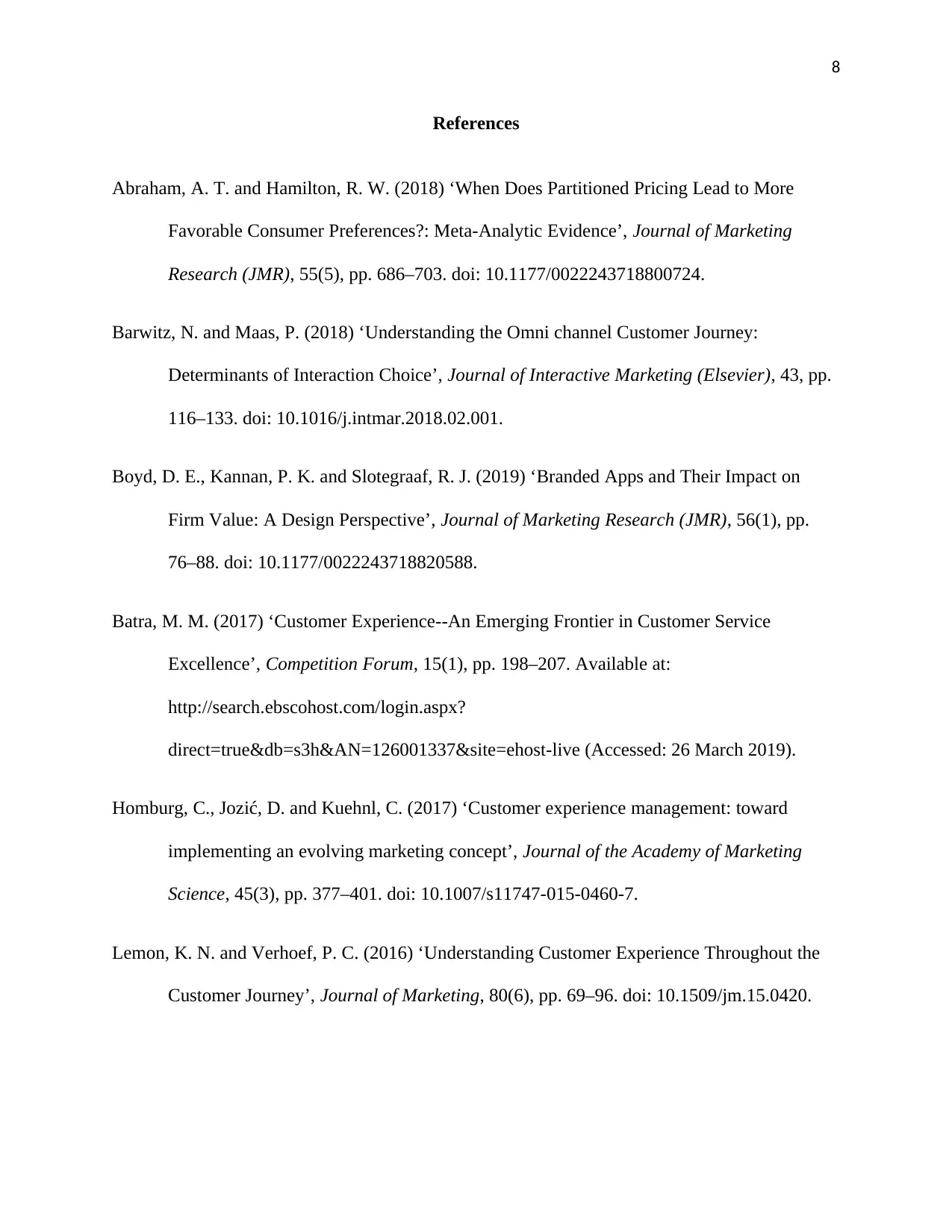
8
References
Abraham, A. T. and Hamilton, R. W. (2018) ‘When Does Partitioned Pricing Lead to More
Favorable Consumer Preferences?: Meta-Analytic Evidence’, Journal of Marketing
Research (JMR), 55(5), pp. 686–703. doi: 10.1177/0022243718800724.
Barwitz, N. and Maas, P. (2018) ‘Understanding the Omni channel Customer Journey:
Determinants of Interaction Choice’, Journal of Interactive Marketing (Elsevier), 43, pp.
116–133. doi: 10.1016/j.intmar.2018.02.001.
Boyd, D. E., Kannan, P. K. and Slotegraaf, R. J. (2019) ‘Branded Apps and Their Impact on
Firm Value: A Design Perspective’, Journal of Marketing Research (JMR), 56(1), pp.
76–88. doi: 10.1177/0022243718820588.
Batra, M. M. (2017) ‘Customer Experience--An Emerging Frontier in Customer Service
Excellence’, Competition Forum, 15(1), pp. 198–207. Available at:
http://search.ebscohost.com/login.aspx?
direct=true&db=s3h&AN=126001337&site=ehost-live (Accessed: 26 March 2019).
Homburg, C., Jozić, D. and Kuehnl, C. (2017) ‘Customer experience management: toward
implementing an evolving marketing concept’, Journal of the Academy of Marketing
Science, 45(3), pp. 377–401. doi: 10.1007/s11747-015-0460-7.
Lemon, K. N. and Verhoef, P. C. (2016) ‘Understanding Customer Experience Throughout the
Customer Journey’, Journal of Marketing, 80(6), pp. 69–96. doi: 10.1509/jm.15.0420.
References
Abraham, A. T. and Hamilton, R. W. (2018) ‘When Does Partitioned Pricing Lead to More
Favorable Consumer Preferences?: Meta-Analytic Evidence’, Journal of Marketing
Research (JMR), 55(5), pp. 686–703. doi: 10.1177/0022243718800724.
Barwitz, N. and Maas, P. (2018) ‘Understanding the Omni channel Customer Journey:
Determinants of Interaction Choice’, Journal of Interactive Marketing (Elsevier), 43, pp.
116–133. doi: 10.1016/j.intmar.2018.02.001.
Boyd, D. E., Kannan, P. K. and Slotegraaf, R. J. (2019) ‘Branded Apps and Their Impact on
Firm Value: A Design Perspective’, Journal of Marketing Research (JMR), 56(1), pp.
76–88. doi: 10.1177/0022243718820588.
Batra, M. M. (2017) ‘Customer Experience--An Emerging Frontier in Customer Service
Excellence’, Competition Forum, 15(1), pp. 198–207. Available at:
http://search.ebscohost.com/login.aspx?
direct=true&db=s3h&AN=126001337&site=ehost-live (Accessed: 26 March 2019).
Homburg, C., Jozić, D. and Kuehnl, C. (2017) ‘Customer experience management: toward
implementing an evolving marketing concept’, Journal of the Academy of Marketing
Science, 45(3), pp. 377–401. doi: 10.1007/s11747-015-0460-7.
Lemon, K. N. and Verhoef, P. C. (2016) ‘Understanding Customer Experience Throughout the
Customer Journey’, Journal of Marketing, 80(6), pp. 69–96. doi: 10.1509/jm.15.0420.
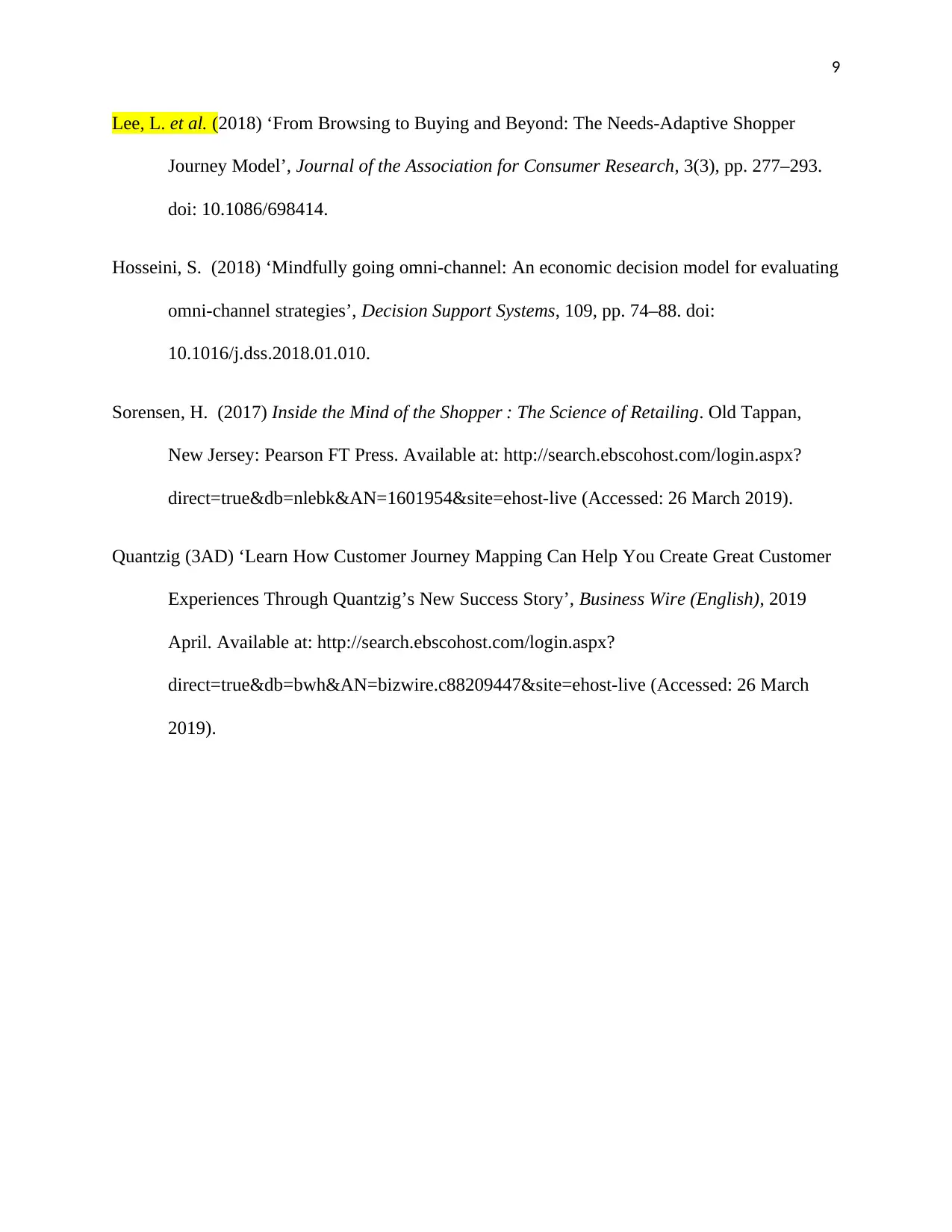
9
Lee, L. et al. (2018) ‘From Browsing to Buying and Beyond: The Needs-Adaptive Shopper
Journey Model’, Journal of the Association for Consumer Research, 3(3), pp. 277–293.
doi: 10.1086/698414.
Hosseini, S. (2018) ‘Mindfully going omni-channel: An economic decision model for evaluating
omni-channel strategies’, Decision Support Systems, 109, pp. 74–88. doi:
10.1016/j.dss.2018.01.010.
Sorensen, H. (2017) Inside the Mind of the Shopper : The Science of Retailing. Old Tappan,
New Jersey: Pearson FT Press. Available at: http://search.ebscohost.com/login.aspx?
direct=true&db=nlebk&AN=1601954&site=ehost-live (Accessed: 26 March 2019).
Quantzig (3AD) ‘Learn How Customer Journey Mapping Can Help You Create Great Customer
Experiences Through Quantzig’s New Success Story’, Business Wire (English), 2019
April. Available at: http://search.ebscohost.com/login.aspx?
direct=true&db=bwh&AN=bizwire.c88209447&site=ehost-live (Accessed: 26 March
2019).
Lee, L. et al. (2018) ‘From Browsing to Buying and Beyond: The Needs-Adaptive Shopper
Journey Model’, Journal of the Association for Consumer Research, 3(3), pp. 277–293.
doi: 10.1086/698414.
Hosseini, S. (2018) ‘Mindfully going omni-channel: An economic decision model for evaluating
omni-channel strategies’, Decision Support Systems, 109, pp. 74–88. doi:
10.1016/j.dss.2018.01.010.
Sorensen, H. (2017) Inside the Mind of the Shopper : The Science of Retailing. Old Tappan,
New Jersey: Pearson FT Press. Available at: http://search.ebscohost.com/login.aspx?
direct=true&db=nlebk&AN=1601954&site=ehost-live (Accessed: 26 March 2019).
Quantzig (3AD) ‘Learn How Customer Journey Mapping Can Help You Create Great Customer
Experiences Through Quantzig’s New Success Story’, Business Wire (English), 2019
April. Available at: http://search.ebscohost.com/login.aspx?
direct=true&db=bwh&AN=bizwire.c88209447&site=ehost-live (Accessed: 26 March
2019).
⊘ This is a preview!⊘
Do you want full access?
Subscribe today to unlock all pages.

Trusted by 1+ million students worldwide
1 out of 9
Related Documents
Your All-in-One AI-Powered Toolkit for Academic Success.
+13062052269
info@desklib.com
Available 24*7 on WhatsApp / Email
![[object Object]](/_next/static/media/star-bottom.7253800d.svg)
Unlock your academic potential
Copyright © 2020–2025 A2Z Services. All Rights Reserved. Developed and managed by ZUCOL.





